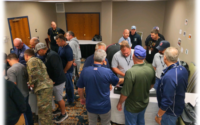The conundrum of cross sensitivity!
Toby Bevelacqua
Let’s first define cross sensitivity or sometimes called restrictive gases, or interference gases, either name suggests that when a gas other than the target gas has entered the instrument, that the reading is NOT the gas that the sensor is designed for, but rather a gas which the instrument responds to at some degree. An example of this and the most prevalent is hydrogen entering the carbon monoxide sensor. In this case the carbon monoxide sensor thinks hydrogen is CO and responds to that cross sensitivity. If the operator does not know about cross sensitivity or doesn’t consider it, valuable time during the hazmat investigation will be lost.
Many hazardous vapors and gases interfere with the proper operation of monitoring instruments. These interferences can result in decreased instrument sensitivity or false
readings as the one described above. For example, silicone sprays used to clean a variety of surfaces can attach to the Pellistor bead in your LEL sensor reducing the sensitivity of the LEL and giving you a false sense of security as the numbers will be muted. This same result on the LEL sensor occurs when metal fumes have entered the instrument changing the resistance values of the Catalytic Bead array. Humidity, and temperature changes can interfere with the readings of a photoionization detector, causing the window where the ultraviolet light comes out to have condensation, skewing the light energy thus reducing the electron volts and lowering the potential electron release. High levels of CO2, over a period of time, may degrade the oxygen sensor. Even your oxygen sensor has cross sensitives, not many, however the responder should be aware of these inconsistencies and plan your mission accordingly.

But what we really want to talk about is the cross sensitives or interference gas/vapors (and included are inhibition gases) that you will see with electrochemical sensors. These sensitivities have caused responders to make inappropriate decisions based upon what they thought was occurring in the test environment (for discussion here the test environment is the environment that you are measuring to prove the level of safety). One simple overarching rule is that when you see the numbers especially with your electrochemical sensors the question to ask is “do they make sense”. One primary example is when extremely high levels of hydrogen sulfide is present you may not get a true reading however if you have a cyanide sensor within your instrument you will see the cyanide readings extremely high. This is due to the cross sensitivity of the cyanide sensor and oversaturation of the hydrogen sulfide sensor.
In these cases of cross sensitivity, or better yet these types of HazMat alarms, one must ask whether you are dealing with a mixed gas environment or a single gas situation. The reason this is important is that cross sensitivities, the ones that are known to certain electrochemical sensors, have a variety of proportional interferences. What I mean by that is you may get a one to one, or a one to 10, ratio of sensitivity or you may get negative numbers. Mixed gases sometimes are displayed as the sum of those gases as the instrument interprets the chemistry and if the gas gives a negative sensitivity, then that may offset the positive display of the electrochemical sensor. You may see positive increases and negative decreases on your display. An example of this is Sulfur dioxide has a negative response to nitrogen oxides, so when a sulfur dioxide sensor specifically sees nitrogen dioxide at say the same time as reading the SO2 because of this negative response at low parts per million you will see zero on your meter thinking that the environment is safe. Additionally at higher concentrations of the Sulfur dioxide your readings may be skewed negatively when NOx are present.

Depending on your instrument, it has a filter that tries to reduce the amount of interference to a specific chemical sensor. However, one must remember that every sensor has some level of cross sensitivity where if the machine has not been able to filter it out then there is going to be a reaction on the electrode giving you a reading. It is up to you to figure out is it a false reading?
All hazmat incidents have their challenges, one of the largest challenges is going to be the metering of the environment to identify potential hazardous substances and considering the area safe or to what degree it is safe. Some of the common sources of cross contamination or cross sensitivity or interference are going to be things like vehicle exhaust, carbon monoxide, sulfur oxides, nitrogen oxides, as examples. Cleaning chemicals (this would include your household cleaning chemicals as well and hand sanitizers – as an example some of the air fresheners have negatively skewed the oxygen sensor) can cause a variety of different interferences which will cause your instrument to alarm. Emergency generators (giving off CO, SOx NOx), battery chargers (Hydrogen the biggest producer with liquid acid batteries, Computer UPS systems have been reported to produce mild levels of interference gases to the CO sensor). Within the general construction industry, site equipment and fuels all can lead to the alarm being sounded.
Another phenomenon that occurs is when you have a chemical that will inhibit the chemistry within the sensor. What is happening within the sensor is that the sensor does not respond to the target gas after it has been exposed to the inhibitor gas at the same time or in close time proximity to the sensor it will not react to the target gas. This inhibiting phenomenon can cause your meter not to respond for several days after incident. Hence a good reason to bump test before and after any meter use. An example of this is chlorine sensor can become “desensitized” in the presence of Hydrogen Sulfide. In other words, the chlorine sensor may not work after exposure to H2S.
OK so now that you have read this now, that you see this now, that you have digested this information; you’re saying well what the hell! To be honest with you, it’s not that bad. First of all, you must look at all the numbers you can’t just rely on one specific sensor. How I like to look at an environment from a gross detection standpoint is to look at the volumetric first then the PID, then the electrochemical sensors. This gives me a good overview of the environment.
My volumetric sensors are the oxygen sensor and the LEL sensor. Both are based upon the volume in the room or the environment. Now I will say the oxygen sensor is not a good sensor to describe a hazard. However, if I see my oxygen drop below 20.8% I am concerned don’t wait till you get to 19.5% you should be concerned at 20.7% and do something!
The next sensor is my LEL sensor. Now with my LEL sensor even though I am blind to about 500 parts per million on the bottom end it will give me a decent amount of information in low level environments. Understanding that this sensor is giving me the level of flammability concern.
Next is my organic vapors, my PID numbers. If I have 10 parts per million on my VOC’s there is a chemical in the room. At 25 parts per million I should take some form of an action that may be ventilating the space, or ensuring my personnel are breathing off their air pack. At 50 parts per million which is first alarm, I have moved towards 50% of the time weighted average for 50% of the chemicals that are out there. At 100 parts per million I’ve exceeded all time weighted averages. At 200 parts per million or second alarm I am approaching IDLH or LEL conditions.
From there I move on to my electrochemical sensors, specifically my carbon monoxide sensor. Back in the old days, this was considered a poor man’s PID. The reason is because the carbon monoxide sensor has cross sensitivities to hydrogen, and petroleum products. If you’re in an environment that has either hydrogen or petroleum, consider the number on your carbon monoxide sensor and your LEL.
As stated, all electrochemical sensors – let me say all sensing technologies – have areas that are limited. Electrochemical sensors, oxygen sensors, LEL sensor, PID’s all have their limitations. It is understanding what these limitations are and how we can use those limitations to our advantages during a hazardous materials event. When reading data from your instrumentation always question do these numbers make sense. Do not take them at face value. There is science behind all these sensors and all these sensors are performing if maintained properly to the level of how they were designed. It is up to you to consider the scene, instrumentation data, and what people are telling you happened within the environment. All these data points are going to help you decide if you have a true number on my sensor or is there a possibility of cross sensitivity.




